|
 Marasmius curraniae Marasmius curraniae
BiostatusPresent in region - Indigenous. Endemic
Images (click to enlarge) | 
Caption: Fig. 6 (1-4). Marasniius curranii G. Stevenson (K, holotype).- 1. Basidiospores.- 2. Basidia.-3.
Cheilocystidia.-4. Pileipellis. | 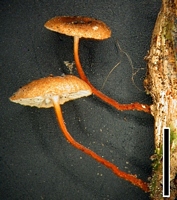
Caption: scale=5mm
Owner: J.A. Cooper | 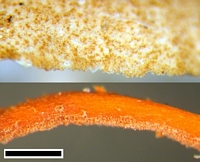
Caption: scale=0.5mm. Upper cap, lower stem.
Owner: J.A. Cooper | 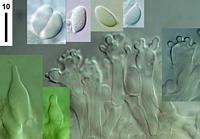
Caption: spores and 2 kinds of cheilocystidia
Owner: J.A. Cooper | 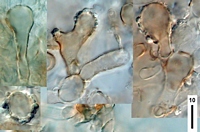
Caption: terminal cap cells
Owner: J.A. Cooper | 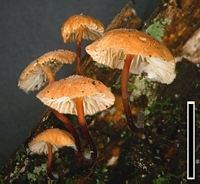
Caption: scale=5mm
Owner: J.A. Cooper | 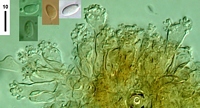
Caption: spores and cheilocystidia
Owner: J.A. Cooper | 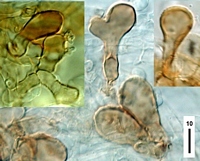
Caption: cap cystidia. Just a few with ornamentation.
Owner: J.A. Cooper | 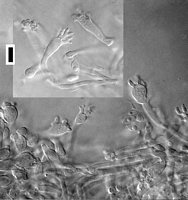
Caption: scale = 10um. Siccus broom cheilocystidia.
Owner: J.A. Cooper | 
Owner: J.A. Cooper |
Article: Stevenson, G. (1964). The Agaricales of New Zealand: V. Kew Bulletin 19(1): 1-59.
Description: Pileus 5-13 mm diam., cinnamon darker at centre, hemispherical with slightly flattened or umbilicate centre, velvety. Gills moderately distant, adnate, margins minutely serrulate. Stipe 6-10 x 1 mm, cinnamon above, ferruginous below, pruinose, curved, tough. Spores 7-8 x 4 µm, non-amyloid; hymenophoral trama with weakly pseudo-amyloid elements and some hyphae with thickened walls. Cuticle of loosely woven large diam. hyphae with clamp connections, faintly amyloid, with inflated endings (Fig. 2/21) P-37).
Habitat: Inserted in bark of dead wood, Butterfly, Wellington, 11.2.1958, M. Curran in Stevenson (type).
Article: Desjardin, D.E.; Horak, E. (1997). Marasmius and Gloiocephala in the South Pacific Region: Papua New Guinea, New Caledonia, and New Zealand taxa. Bibliotheca Mycologica 168: 152 p.
Description: Pileus 5-20 mm diam, hemispherical to convex when young, expanding in age to plano-convex with a
slightly depressed disc, with or without an indistinct obtuse umbo, subplicate towards the margin;
surface dull, dry, minutely granular-punctate especially over the disc; pale beige-brown with reddish
brown tones when young, disc remaining so in age, becoming paler towards the margin. Texture tough,
membranaceous context thin, buff to pale concolorous with pileus surface.- Lamellae adnate to slightly
subdecurrent, subdistant (912) with 2-series of lamellulae, up to 1.5 mm wide, often anastomosing, off-white to pale cream or pale beige; edges fimbriate, concolorous.- Stipe 6-15 x 0.5-1.0 mm, central or
seldom eccentric, cylindrical, equal or slightly attenuated towards the base, apex granulose, base
glabrous, tough, solid, insititious, apex orangish brown to dark reddish brown, almost black near the
base; rhizomorphs absent.- Odor and taste strong, like garlic.
Basidiospores 7-8(-10) x 4.0-4.5(-5.0) µm, ellipsoid, smooth, thin-walled, hyaline, inamyloid.- Basidia
20-40 x 5-6 µm, cylindrical to subclavate, 4-spored, clamped.- Cheilocystidia 15-30x6-10 µm ,
polymorphic, subcylindrical, clavate or irregular in outline, hyaline, thin-walled to slightly thick-walled
(up to 0.5 µm); apical diverticula 1-7 x 1-2 µm , irregular in outline, often nodulose or forked, hyaline.-
Pleurocystidia absent.Pileipellis a loosely organized, hymeniform layer of clavate to irregularly shaped
cells, 20-50 x 7-15 µm, some with broad lobes or outgrowths, some irregularly roughened, thin-walled to
thick-walled (up to 1.0 µm), yellowish brown, inamyloid; cells on disc more tightly organized.- Pileus tramal hyphae thin-walled to
thick-walled, subgelatinous, inamyloid.- Stipe tissue monomitic; cortical hyphae cylindrical,
thick-walled, roughened, yellowish brown, inamyloid.-Caulocystidia absent.-Clamp connections
present.
Habitat: Habit, habitat and distribution.- Solitary, in groups on rotting bark of twigs or logs of myrtaceous
trees (Leptospermum sp. or Metrosideros umbellata). Host substrate for type unknown.
Notes: Marasmius curranii is characterized by the following features: a small, convex, beige-brown
pileus; subdistant lamellae (9-12); a short, glabrous, reddish brown, insititious stipe; strong
alliaceous odor and taste; growth on myrtaceous wood; relatively small basidiospores;
diverticulate cheilocystidia; inamyloid tisues; and a hymeniform pileipellis of smooth or seldom
nodose clavate cells. In combination, these features indicate placement in sect. Chordales, not
sect. Globulares as suggested by Stevenson (1964).
Marasmius curranii is the New Zealand homologue to the north temperate M. scorodonius (Fr.:
Fr.) Fr. The latter species differs only subtly from M. curranii in forming more robust basidiomes
with yellowish brown pilei 15-30 mm broad and stipes 40-60 x 1-3 mm, crowded lamellae (15-30), and slightly longer basidiospores (8-10 µm; mean = 8.5-9.0 µm). The smaller M.
scorodonius var. virgultorum Malengon & Bertault (1975), described from Morocco, may be a
later synonym of M. curranii. In the Southern Hemisphere, M. curranii is allied with M.
cinnamoneus Cleland (1934), a species described from material collected on Eucalyptus bark in
Australia. Marasmius cinnamoneus differs, however, in lacking a garlic odor in fresh or dried
material, and in forming larger basidiospores measuring 9-12 x 4.5-6.0 µm (isotype and two
syntypes, AD!).
|